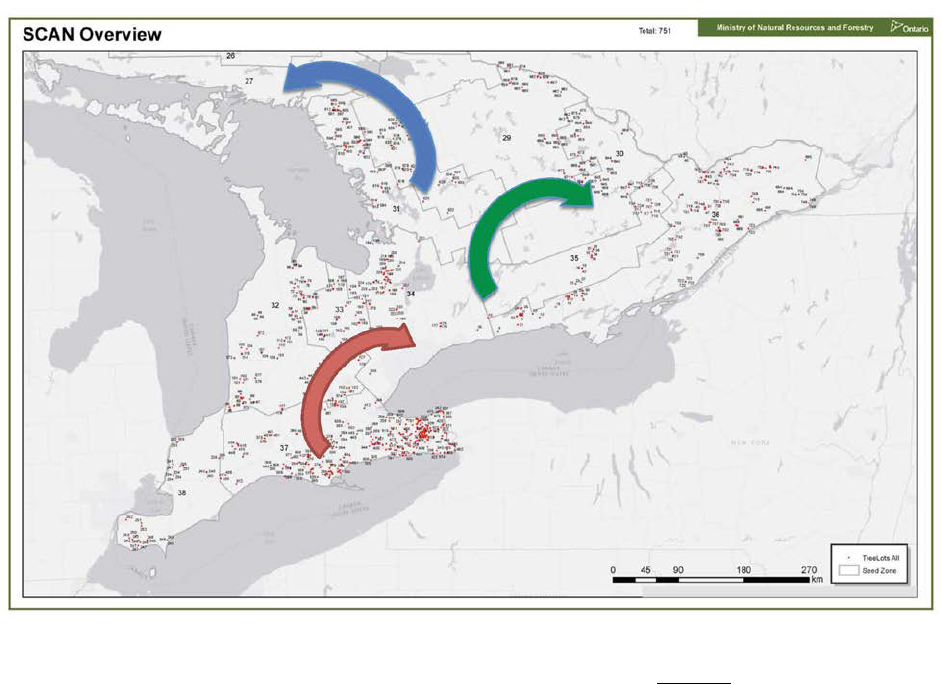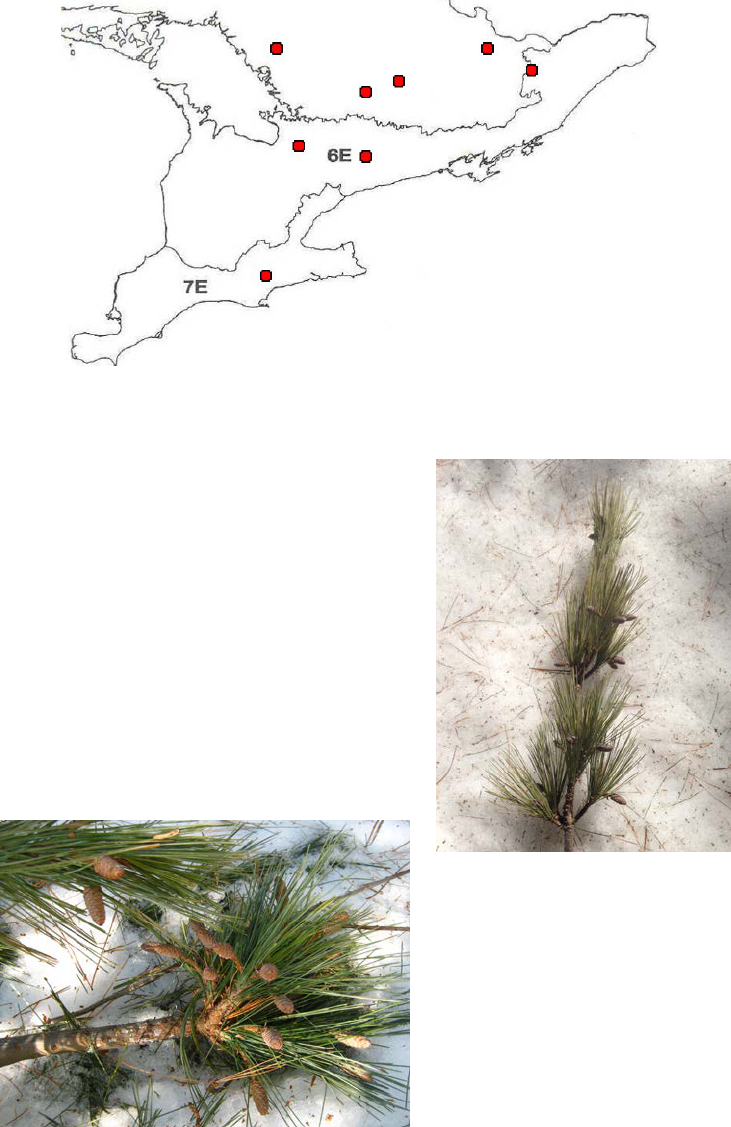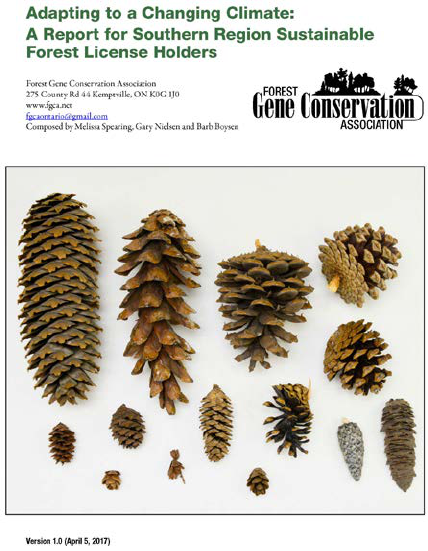
1
Annual Report
2016-2017
2016/2017 was our 22nd year as a southern Ontario association focussed on forest genetic resource management. It
has always been an exciting challenge. Exciting, given the huge diversity of our forests and our members and
associates; and challenging, given that the level of financial support has been inversely proportionate to the threats
to our forest diversity.
The FGCA Board has managed the uncertainties with conservative financial planning, as well as an eye to succession
planning. And though the last 2 years could be considered our most uncertain, this year the stars aligned. We were
granted long term financial support via the Forestry Futures Trust (FFT) and a letter of partnership from MNRF
Minister McGarry. This support is allowing us to hire our first employees who bring to our program an impressive
combination of experience, expertise and passion for our mandate. Melissa Spearing, for now part time, is our Seed
Program Coordinator, and Heather Zurbrigg is our full time Species Conservation and Administration Coordinator.
This team is rounded out by an engaged and diverse Board of 12 Directors, and the support of many expert
contractors who provide local operational support. You will see their names throughout this report.
The Forestry Futures Trust support is limited to programs that benefit the crown forests in central Ontario. Last
year’s initial efforts focused on these crown forests were expanded this year with the production of a report for the
four Sustainable Forest License holders and the Algonquin Forest Authority, who collectively manage the central
Ontario crown forests - Adapting to a Changing Climate: A Report for Southern Region Sustainable Forest License
Holders. This is an excerpt from its executive summary
As the past will no longer be the best guide for forest stand development, forest practitioners will have
to bring considerations of climate change adaptation into routine planning and operations. Above all,
a clear understanding of forest genetic resource management principles is necessary. A companion
document – a Forest Genetic Resource Management Checklist will help ensure adaptive management
proposals conserve genetic diversity, the foundation of future forest resilience, no matter the threat.
Unfortunately, there is yet no similar support for forest genetic programs in the southern private landscape, but the
work done for central Crown forests, such as the above report can serve as an example. To this end this report will
be circulated among all FGCA members and associates. The reality is that our southern FGCA members’ and
associates’ efforts in their forests will give the central crown forests options for the future. We were happy to see
this perspective endorsed this spring by the FFT committee who approved an application to manage the southern
Ontario white pine seed orchards to provide high quality seed for central Ontario’s crown forests.
Support for gene conservation of all Ontario’s forests is necessary if we are to meet the challenge of climate change.
With the help of members and associates we will continue to fundraise and deliver our southern programs including
species conservation, the Seed Collection Area Network, assisted migration trials and the general promotion of gene
conservation principles and practices. As always, we’d love to hear from you about the work we have done and plan
to do. You’ve now got 3 to contact - Heather, Melissa or me – give us a shout.
Barb Boysen, FGCA General Manager
275 County Road 44, Kemptville ON K0G 1J0 www.fgca.net [email protected] heather@fgca.net melissa@fgca.net

2
This report is presented as per the Goals in the FGCA 5-year Strategic Plan
I. Biologically Appropriate Reforestation: Increase quality/quantity of source-identified, native species seed
II. Promotion of Gene Conservation Principles - Increase awareness of FGCA program among forest management
and conservation sectors.
III. Species Conservation & Restoration - Increase awareness of native species diversity and threats to their status,
and develop programs for recovery
IV. Climate Change Adaptation - Increase awareness and use of genetic resource management principles to help
conserve and improve existing native forest resilience.
V. Effective, responsive, fiscally viable organization - Maintain a NFP corporation and serve its membership.
Our programs could not succeed without our many partners; these people are bolded and their organizations
underlined. Contact Barb Boysen if you want more detail on any of the programs described briefly below.
I. Biologically Appropriate Reforestation
Ontario’s Natural Selections (ONS) Seed Source Certification Program
• The new manual, Seeds of Ontario Trees & Shrubs (2014) was widely distributed with the help of the staff at
the MNRF Ontario Tree Seed Plant and Forests Ontario.
• It can be purchased from the FGCA or the Ontario Tree Seed Plant. If you are a Certified Seed Collector (CSC)
one copy is available to you at reduced price.
• The CSC list was reviewed to update contact information – though we have taught hundreds, only dozens are
active and we are adjusting our focus.
• Melissa Spearing continued with a 3-day CSC workshop curriculum revision based on the new seed manual,
as well as an online version, assisted by Seed Review team: Barb Boysen, Brian Swaile, Ron Thayer, Kerry
McLaven, Charity Dobbs, and Sarah Drabble-Bisgould
• Forests Ontario managed a waiting list for people interested in 2017 CSC workshops
• Colleges have expressed interest in incorporating the curriculum in their courses, including Fleming College,
Niagara Parks Botanical Garden, and Fanshawe and Humber horticultural programs.
Forests Ontario (FO) and 50 Million Tree Program
• Much of our work is coordinated with Forests Ontario’s Seed and Stock Management Plan, a comprehensive
document that links all aspects from the forest producing the seed to the growers shipping the seedlings and
the significant planning that is required to ensure that the Right Tree is planted in the Right Place.
SFL seed source tracking and seed banking system
• Melissa Spearing worked with SFL staff to review the current systems and make recommendations for
improvement Summary of 2016 SFL discussions:
• Older seedlots’ source documentation is usually limited to year and seed zone or former MNR district.
• Seed forecasting is carried out informally
• Seed banks are maintained at OTSP, and all seed is processed at OTSP
• Seed source documentation for new collections is not rigorous. A documentation system is in place, but it is
not emphasized. The OTSP, some SFLs and most growers will bulk by seed zones to keep costs down

3
• The need to be more specific is recognized as the only way to utilize new tools and minimize risks with
climate or latitude-based focal-point transfer functions.
• Examples of 10-yr seed banking recommendations were calculated and presented in 2017 SFL Adapting to a
Changing Climate report (pg 42). This report’s Appendix A includes fact sheets of substantially reviewed seed
banking information for 10 species (another 5 to come) for weighing natural regeneration with the need to
collect high-quality seed. Most important species to Central Ontario can be banked for 30-100+ years, as
based on experiments and records kept at the National Tree Seed Centre.
Seed Collection Area Network - SCAN
• Over 750 sites of 45 species are mapped – Melissa Spearing and Gary Nielsen coordinated input from
contributors across southern Ontario, supported by MNRF Information management specialists
• Climate analyses of individual sites has started and future seedlot tracking will give us options for strategic
assisted migration
Manage Crown SCAN site Priorities - Melissa Spearing, Gary Nielsen, SFL staff
• An assessment was done of how we have met the goal of a minimum of 3 stands per species per seed zone in
the database, set to enhance procurement options in lean seed years. This formed the basis of a renewed
target list that will enhance SeedWhere procurement options for common species, and conservation stands
for regionally rare or SAR species. 5 packages were prepared for the 4 SFLs plus the Algonquin Forest
Authority identifying needed SCAN sites. The maps also included the records from the National Tree Seed
Centre as a potential assistance in locating species in Central Ontario given Petawawa’s extensive sampling
for research projects throughout the region.

4
• Reviewed the need for ground-truthing for health and seed potential, for minimum requirements by number
of individuals needed for genetically diverse seed production, for access issues or unmanaged past-prime-
aged plantations.
Manage southern private land SCAN sites - Melissa Spearing, Gary Nielsen
• Provided supplemental gap packages to Conservation Authorities outside the AOU to solicit future seed
sources for potential use and banking by SFLs.
Build FGCA SeedWhere analysis capacity
- Melissa Spearing
• Acquired GIS hard and software to be able to work with SeedWhere and other tools
• Worked with NRCAN to build a SeedWhere adaptation to allow analyses.
• Scenarios done for Somerville Nurseries, Forests Ontario, Ganaraska Forest, and for presentations e.g. re
assisted migration.
• Explored other climate analyses options while attending the US National Native Seed Conference participated
in several workshops demonstrating US seed transfer tools., particularly Brad St. Clair’s (US Forest Service)
Seedlot Selection Tool (SST) which is being supported by the Canadian Forest Service to provide funding for
extending coverage and transfers to the eastern half of North America in April 2017.
White Pine Seed Orchard Management
– Melissa Spearing, Gary Nielsen, Barb Boysen, Brian Swaile, Forests Ontario, SFLs
Reaffirmed FGCA Long Term Objectives for White Pine Clonal Seed Orchards
• The overall goal is to create a demand for high quality White Pine seed by capitalizing on past investments
and bringing all Seed Orchards to a standard level of management
• Recommended that Southern Ontario seed orchard seed be used by SFLs in the AOU in the near-term future
to the Forestry Futures Trust and MNRF
• Recommended White Pine as a likely Climate Change Winner (see FGCA report: Adapting to a Changing
Climate: A Report for Sustainable Forest License Holders) and promoted the Seed Orchard network as a
seed factory for high quality seed
• Established a monitoring protocol that can be implemented cost effectively
• Used GIS to generate a thinning regime according to a set of rules, to be used as a guide by qualified tree
markers who will make the final decision before marking trees
• Planned a final thinning in 10 years to bring all orchards into the optimal 1-in-4 tree remaining spacing and
condition for seed production.
5 SFL orchards within the AOU of the Southern Region:
• Conger is managed by Westwind Forest Stewardship, Snowdon and Crowe River are managed by Bancroft
Minden Forest Company, Gratton is managed by Ottawa Valley Forest and Taylor Lake is managed by
Mazinaw Lanark.
• Updated management plans
• No crop in 2016 but forecasted potential for a collectable crop in 2017

5
3 Private Land area orchards:
• Glencairn, Scugog and Cayuga are seed orchards south of the AOU that FGCA is managing with local partners.
To date, no work on these three orchards was funded by the FFT. However, they are of significant value to
the SFLs in their plans for climate change adaptation and should be viewed by MNRF as superior sources of
seed for white pine planting objectives given climate change projections.
• No crop in 2016 but forecasted
potential for a collectable crop
in 2017
Digital File Management in all
orchards
• Melissa Spearing updated
records for GIS capacity to
monitor, document and plan
operations to maintain clonal
representation and therefore a
broad genetic base
Planning 2017 Crop Collection and Crown Management (thinning & topping) in all 8 orchards
• Update Management Plans
• Maintain clonal tree labels.
• Thinning Plan and Marking: guided by GIS digital thinning exercise
• Thinning
• Topping
• Annual removal of damage
• Annual mowing
• Annual monitoring
• Annual crop forecasting
• Cone harvest whenever possible; coordinated with crown
management operations
Conelets on snow-broken branches
– indication of potential for 2017 cone crop
L – Taylor Lake SO; R Snowdon SO
Taylor Lake
Scugog
Gratton
Conger
Crowe River
Glencairn
Cayuga
Snowdon
6
II. Promotion of Gene Conservation Principles:
Forest Genetic Resource Management Checklist for Forest Managers
• FFT funding supported Melissa Spearing and Barb Boysen’s work on a report to aid the SFLs
Genetic health is the key to long term forest resilience. Follow this checklist to conserve and restore it.
Reforestation
Define your local “climate” or seed zone
• Understand what factors are in play (lakes, elevation, latitude).
• Be aware of climate change projections for your area, and the potential effects on species growth and on microsites
within a local area.
Review regeneration needs of each species
• Assess the successes and challenges of natural versus artificial regeneration
• Consider climate change stresses on regeneration site conditions that may negatively affect establishment success in
group selection, shelterwood or clearcut systems, and favour species or stock types that may be better adapted.
• Plan for a mix of planted seedlings among natural recruitment to allow for greater natural selection of new genotypes in
a changing climate.
• Plan annual seed needs to inform seed collection and seed banking targets; based on best information about crop
periodicity, viable seed rates and seed to seedling ratios
Select seed collection areas and design assisted migration seed source mixes.
• Use the best climate change projection science available to create seed source mixes:
Local source (50%) - use a low-risk, short frame (20 years)
Southern sources (25-50%) – use a mid-range time frame (40 years)
Most southern sources – (25%) – use a long-range time frame (60 years)
• Focus on genetic quality of the stand – so that any 1 seedlot from any 1 source is made up of seed from many
individuals (genotypes) to ensure a broad genetic base (>100 individuals of common spp, >5 for scattered spp).
Collect an adequate supply of source-identified, high quality seed
• Ensure collections are done in good seed years when the seed’s genetic and physiological quality will be at a maximum.
• Document seed source information so it can be deployed strategically
• Maintain seed source information from collection to planting so performance can be related back to seed source.
Bank an adequate supply of source-identified, high quality seed;
where a 5-year supply was once considered adequate, climate change effects make a 10-year supply a safer
strategy due to potential changes in seed crop frequency.
Locate and maintain seed production areas for species where banking is not an option
within each climate zone, locate several high-quality stands which will increase the opportunity to annually harvest
seed, even in generally poor seed years (particularly important for species such as oaks, hickories).
Forest stand improvement, harvesting and natural regeneration
Be aware of climate change projections for your area
Assess the potential effect on local species health and reproductive potential

7
Develop strategies to conserve unique and disjunct populations and species.
Assess their role as edge of range populations which can inform climate change effect monitoring and
contribute to assisted migration strategies
Monitor their resilience as climate change progresses.
Allow/mimic natural disturbances to retain adaptation for related traits (e.g. fire).
When managing for early succession species
Minimize single-tree selection and small-group selection harvesting, or encourage opening sizes greater than
15 hectares to reduce inbreeding problems and encourage regeneration of these species. This general principle
must be adjusted to the socio-economic realities and land use history of an area, e.g. reduce opening sizes.
Ensure stand management maintains a broad, adapted genetic base
Consider climate change effects on microsite conditions and the existing species’ adaptation potential e.g. dry
sites becoming droughtier
Retain many large, healthy, interbreeding individuals (see Ontario Tree Marking Guide) until natural
regeneration is well established.
Retain trees exhibiting tolerance to insect and disease problems.
Discourage diameter-limit cutting, which leaves a residual stand of often poorer quality trees, which can reduce
the genetic quality of the next generation.
Consider live culls and minimize the number if they might contribute to the next generation as a form of
negative selection. Coordinate leave tree guidelines with wildlife objectives.
E-mail
• Articles and news items were distributed to FGCA members and associates
• Seed Manuals were promoted and sold via a Forests Ontario via a message to the Seed Workshop waiting list
Presentations
• Barb Boysen, Heather Zurbrigg and Melissa Spearing attended the October 4, 2016: Forest Ontario and
Upper Thames River CA Fall PDA Planting Partner Field Tour to talk about butternut and assisted migration.
• Melissa Spearing presented - Shooting a Moving Target – Conserving & Restoring Forests in a CC at:
- Community Forest Managers Meeting on October 17, Northumberland County
- Trenton Woodlot Conference, Nov. 25: Heather Zurbrigg manned Display; promoted butternut search
• Melissa Spearing presented a Seed Source Matters at the November 30 Landscape Ontario Growers Group
Meeting; distributed information including a letter from MNRF recognizing FGCA seed zone efforts
• Heather Zurbrigg hosted Display at Kemptville woodlot conference; promoted search for butternut trees
Attendance at Meetings:
Melissa Spearing attended
• February 10, 2017: Forest Ontario’s AGM in Nottawasaga, ON.
• February 11, 2017: Kawartha Woodlot Conference at Fleming College in Lindsay, ON
• February 12-16, 2017: US National Native Seed Conference, Washington, D.C.
Website
• Maintained www.ontariosnaturalselections.org and www.fgca.net
FGCA Meetings - Annual General Meeting – June 21st & 22nd, 2016, Best Western Hotel, Milton Ontario

8
III. Species Conservation
Butternut Conservation & Recovery
Heather Zurbrigg, Barb Boysen, Rose Fleguel, Virginia Gordon, Greg Bales, Karen Dykxhoorn, Terry Schwan,
Steve Bowers, Ferguson Forest Centre, Upper Thames River CA
• 5-year Archive Program Plan that details expertise and training, techniques, facilities and data management
• Grafting
o Grafted 10 trees in April 2016, tended 1- year-old grafts of 10 trees, outplanted 2-year-old grafts of
10 trees in the butternut archives, prepared rootstock to
support grafting of 10 more trees in 2017
• Archives
o A management plan for each of 3 archives (seed orchards)
o Planning the establishment of 3 new locations
o Pruning tutorial to manage the older grafts; seed collection
from older grafts in EOBSO, Kemptville (see photo)
• Funding
o Managed 24 Butternut archiving agreements supporting the
archiving of 34 trees over 5-year periods
• Expansion
o Planning a Butternut program capacity
expansion at Ferguson Forest Centre to
be able to graft up to 25 trees a year.
• Landowner outreach and archivable Tree Search
o Signed one agreement and planned 2
more to develop a queue of trees to add
to the archive program
• Seed collection and Seedling Sales
o Seed Zone 30 seedlings were contract
grown with Ferguson Forest Centre and
Seed Zone 34 seedlings were contract
grown at Somerville Nurseries
• Government Liaison
o Heather Zurbrigg and Barb Boysen participated in the following:
• Providing comments and attending an information session on the Provincial legislative initiative
of the integration of the Crown Forest Sustainability Act (CFSA) and the Endangered Species Act
• Discussions with Parks Canada on Butternut management and the importance of vigorous
Butternut in the FGCA archiving program
• Providing, coordinating and compiling comments for the update to Butternut status report
Environment Canada
• Assisting with Federal HSP funding proposals through providing comments and input
Ash Conservation
• Melissa Spearing scouted for ash species seed to send to the National Tree Seed Centre.
• Melissa Spearing collaborating with National Tree Seed Centre and the Invasive Species Centre Citizen
Scientist Training project to enable ash seed collections in northern Ontario in 2017

9
IV Climate Change
Assisted Migration and Seed Production Area Trials in Southern Ontario
- FGCA worked with Forests Ontario and local partners:
o To improve tagging, and where needed refill stock in the following trials:
o 2010 red and white oak trial with Oxford County landowner Phil Holst and John Enright of UTRCA.
o 2011 bur oak trial with Oxford County, and John Enright of UTRCA with plots of local hardwoods to
diversify the site.
o 2012 bur oak trial including plots of mixed hardwoods from SW Ontario for diversity. FGCA worked
with Rick Knapton of Cataraqui Conservation Authority, Friends of Lemoine Pointe
o 2014 bur oak trial with Plantagenet Township and the South Nation Conservation Authority,
o 2016 red and swamp white oak trial was established with Steve Shaw of the St Clair Region Conservation
Authority near Sarnia, assisted by Gary Nielsen
Climate Change Strategies for Central Ontario Crown Forests
- FFT funds supported work by Barb Boysen, Melissa Spearing, Gary Nielsen and SFL staff
• Assisted Migration Trial Planning and Operations
This year’s project built on the 2016 communications with central Ontario SFLs.
o They are interested in assisted migration concepts and Climate Change adaptation strategies.
o There is more interest in establishing and monitoring operational blocks.
o There is interest in using seed mixes of southern stock on an operational basis under the auspices of
an overarching Climate Change adaptation strategy.
o There is interest in establishing southern sources of species as potential seed production areas.
2016 Implementation:
Ottawa Valley Forest (OVF) initiated a red oak production AM planting:
• distinct blocks of seed zone 29, 30 and 36 red oak; bulked seed lot information by zone
• FGCA worked with OVF to analyse climate of stock and develop monitoring protocol
2017 plans:
• OVF worked with FGCA SeedWhere analyses for a black cherry trial on a Westmeath site
• Westwind was provided with analyses to incorporate into their FMU Plan climate change report re sites
for planting and sources of hard maple, white pine, red pine and white spruce
• Southern Seed Agency Network
Central Ontario’s Crown Forest managers must immediately look to neighbours to source high quality seed
that has evolved in the climates central Ontario is predicted to experience within 50 years. The source of this
seed in southern Ontario and the USA is largely on private forest land. This project initiated communications
to build a network to source high quality seed for assisted migration, including:
Southern Ontario SCAN sites - the FGCA developed information packages to distribute to the Conservation
Authorities who manage their own lands and have links to the private landowners in their watersheds.
USA – FGCA Seed Program Coordinator Melissa Spearing attended the US National Native Seed Conference
in Washington, D.C (Feb 2017). https://nativeseed.info/presentations/
and developed contacts to start to
create a GIS database of contacts and review Importation Processes

10
• Adapting to a Changing Climate: A Report for Sustainable Forest License Holders.
This extensive report was developed based on a preliminary report produced last year and expanded upon by
Melissa Spearing, FGCA Seed Program Coordinator, Gary Nielsen, FGCA Climate Change Specialist and Barb
Boysen, FGCA with input from SFL forest managers and assistance from NRCAN and American climate
specialists. Melissa Spearing received contributions from the USA seed group and Natural Resource Canada
(NRCAN) including climate change scenario maps for 15 species x 10 historical and IPCC AR5 climate change
scenarios. A literature search was initiated on 10 species utilizing extensive resources.
This new detailed working document has been distributed to the central Ontario Crown Forest Managers and
the FGCA Board of Directors. As a companion document,
the FGRM Checklist Document (See II.) was also
distributed. Input is being sought via a series of
facilitated meetings with Crown Forest management
staff. This work will continue in 2017/2018 as ultimately,
it is a working document on very complex, evolving
subject.

11
V. Administration:
FGCA Board of Directors
• A 12 Member Board was elected/appointed as per a revised and approved Constitution and By-laws. Meetings
and decisions were made via conference call and email and face to face meetings
Gary Nielsen Forest Consultant, Elected June 2016, Vice-President, FGCA Executive Committee
John Enright Upper Thames River CA, Board member appointed by Conservation Ontario
Steve Munro Westwind Forest Stewardship, Board member appointed by SFL members
Kerry McLaven Forests Ontario, Elected June 2016, FGCA Treasurer, FGCA Executive Committee
Terry Schwan Forest Consultant, Elected June 2016
Aron Fazekas The Arboretum, University of Guelph, Elected June 2016
Glenn McLeod Forest Consultant Elected June 2016, FGCA Secretary, FGCA Executive Committee
Ed Patchell Ferguson Forest Centre, Elected June 2016 FGCA President, FGCA Executive Committee
Steve Smith Forest Consultant Elected June 2016
Rob Davies Essex Region CA, Elected June 2016
Dave Harbec Somerville Seedlings, Elected June 2016
Nancy Young City of Ottawa, Elected June 2016
NFP Corporation
• Minutes were kept; Financial Reports reviewed, and Insurance maintained.
New FGCA Office
In February 2017, the FGCA established an office in Kemptville, renting from the Ferguson Forest Centre at
275 County Road 44, Kemptville Ontario K0G 1J0
